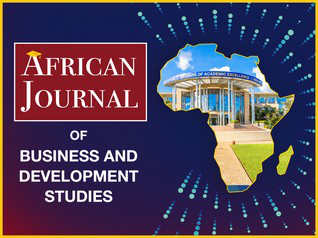Effect of Aircraft Ground Handling Practices on Aviation Safety Performance in Kenya
DOI:
https://doi.org/10.70641/ajbds.v1i2.107Keywords:
Aviation Safety, Aircraft Ground Handling, Passenger Handling, Cargo Handling, Aviation IndustryAbstract
The goal of this study was to examine the effect of ground handling practices on Aviation safety performance in Kenya. Specifically, the study sought to establish the effect of passenger handling practices and cargo handling practices on aviation safety performance in Kenyan context. This study employed an explanatory research design. The target population consisted of 258 staff directly engaged in passenger & cargo handling procedures from five domestic passenger airlines operating from Jomo Kenyatta International Airport (JKIA) Kenya. A census survey of the entire population was carried out, respondents were drawn from four departments; safety, flight operations, ground operations & dispatch. Results revealed a positive and statistically significant effect of passenger handling practices on aviation safety performance (β = .722, p = .000, <0.05). It was also established that cargo handling practices had a positive and significant effect on aviation safety performance (β = .140, p = .006, <0.05). The findings of this study underscore the need for the development and implementation of standardized cargo handling procedures, rigorous training programs for personnel, and the adoption of best practices in ground handling. Such measures are essential for minimizing risks associated with cargo operations and improving the safety culture within the aviation industry. Aviation corporations need to focus on training and development programs for ground handling personnel, especially those engaged in passenger and cargo operations. This will guarantee that personnel possess the requisite skills and knowledge to perform their duties efficiently. The original contribution of this study lies in its focus on ground handling practices and their impact on aviation safety performance in a developing country. In conclusion, it contributes to the existing body of knowledge on aviation safety management and may serve as a basis for further research and policy development in this area.
References
Alamdari, M. (2018). Airline networks: a comparison of hub-and-spoke and point-to-point systems. Routledge.
Alonso Tabares, D., & Mora-Camino, F. (2017). Aircraft ground handling: Analysis for automation. In 17th AIAA Aviation Technology, Integration, and Operations Conference (p. 3425). DOI: https://doi.org/10.2514/6.2017-3425
Bakır, M., Özdemir, E., & Akan, Ş. (2021). A novel MADM approach to the ground-handling agent selection problem in B2B markets. Journal of Advances in Management Research, 18(5), 684-707. DOI: https://doi.org/10.1108/JAMR-05-2020-0069
Button, K. (2017). Low-cost airlines: A contemporary economic and geographical appraisal. Routledge.
Durmaz, V., Yazgan, E., & Yılmaz, A. K. (2021). Ergonomic risk factors in ground handling operations to improve corporate performance. International Journal of Aviation Science and Technology, 2(02), 82-90. DOI: https://doi.org/10.23890/IJAST.vm02is02.0205
International Air Transport Association (IATA). (2021, September 6). What to know about air cargo handling. Retrieved from https://www.iata.org/en/publications/ newsletters/iata-knowledge-hub/what-to-know-about-air-cargo-handling.
International Civil Aviation Organization (ICAO). (2010). Operation of aircraft, Part I – International commercial air transport – Aeroplanes, Annex 6 to the Convention on International Civil Aviation, Ninth Edition, Amendment 34 of July 2010.
International Civil Aviation Organization (ICAO). (2013). Annex 19: Safety management.
International Civil Aviation Organization (ICAO). (2013a). Safety management manual (SMM), Doc 9859/AN/474, Third Edition, May 2013.
John, W. (2015). The global airline industry. Newread.
Kirschenbaum, S. (2018). Airline network development in Europe: A multilevel analysis of airline-airport relationships. Washington, DC: American Psychological Association.
Koenig, F., Found, P. A., & Kumar, M. (2019). Condition monitoring for airport baggage handling in the era of industry 4.0. Journal of Quality in Maintenance Engineering, 25(3), 435-451. DOI: https://doi.org/10.1108/JQME-03-2018-0014
Koestner, R. (2019). Need satisfaction, motivation, and well-being in the work organizations of a former Eastern Bloc country. Air Transport Monthly, 1(1), 147-159.
Koo, L. (2018). The role of ground flight safety in enhancing operational performance. Journal of Air Transport Management, 67, 13-22.
Majid, S., Nugraha, A., Sulistiyono, B., Suryaningsih, L., Widodo, S., Kholdun, A., & Endri, E. (2022). The effect of safety risk management and airport personnel competency on aviation safety performance. Uncertain Supply Chain Management, 10(4), 1509-1522. DOI: https://doi.org/10.5267/j.uscm.2022.6.004
Musa, M., & Isha, A. S. N. (2021). Holistic view of safety culture in aircraft ground handling: Integrating qualitative and quantitative methods with data triangulation. Journal of Air Transport Management, 92, 102019. DOI: https://doi.org/10.1016/j.jairtraman.2021.102019
Ochola, F. O., & Were, D. S. (2018). Influence Of Operational Strategies on Performance of The Air Cargo Handling Projects at Jomo Kenyatta International Airport–Nairobi, Kenya.
Omondi, N. N., & Kimutai, G. (2018). Stakeholder engagement conflicts and implementation of expansion and modernisation projects at Jomo Kenyatta International Airport in Nairobi, Kenya. International Academic Journal of Information Sciences and Project Management, 3(2), 12-36.
Panagopoulos, I., Atkin, C., & Sikora, I. (2017). Developing a performance indicators lean-sigma framework for measuring aviation system's safety performance. Transportation Research Procedia, 22, 35-44. DOI: https://doi.org/10.1016/j.trpro.2017.03.005
Park, K. (2019). A study on the influence of ground flight safety of LCCs’ alliance on competitive advantage. Nevada: Science Publishers.
Patriarca, R., Di Gravio, G., Cioponea, R., & Licu, A. (2019). Safety intelligence: Incremental proactive risk management for holistic aviation safety performance. Safety Science, 118, 551-567. DOI: https://doi.org/10.1016/j.ssci.2019.05.040
Rezaei, J., Fahim, P. B., & Tavasszy, L. (2014). Supplier selection in the airline retail industry using a funnel methodology: Conjunctive screening method and fuzzy AHP. Expert Systems with Applications, 41(18), 8165-8179. DOI: https://doi.org/10.1016/j.eswa.2014.07.005
Studic, M., Majumdar, A., Schuster, W., & Ochieng, W. Y. (2017). A systemic modeling of ground handling services using the functional resonance analysis method. Transportation Research Part C: Emerging Technologies, 74, 245-260. DOI: https://doi.org/10.1016/j.trc.2016.11.004
Wahab, A. (2024, May 2). Passenger handling assistant to support passengers at the airport. AN Aviation Services Co. Retrieved from https://an.aero/passenger-handling-assistant.
Zhou, L., & Chen, Z. (2020). Measuring the performance of airport resilience to severe weather events. Transportation research part D: transport and environment, 83, 102362. DOI: https://doi.org/10.1016/j.trd.2020.102362
Downloads
Published
How to Cite
Issue
Section
License
Copyright (c) 2025 Jones Bor, Gloria Beth Muthoni

This work is licensed under a Creative Commons Attribution-NonCommercial-ShareAlike 4.0 International License.





 This work is licensed under a
This work is licensed under a 